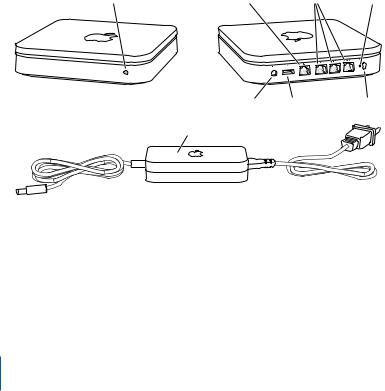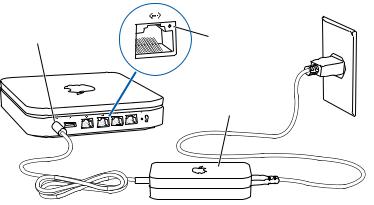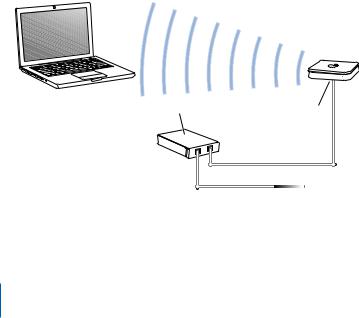Apple AIRPORT EXTREME GIGABIT Setup Guide

AirPort Extreme
Setup Guide

Contents
4Chapter 1: Getting Started
5About AirPort Extreme
6About the AirPort Software
7What You Need to Get Started
10AirPort Extreme Status Light
11Chapter 2: AirPort Extreme Networks
12Using AirPort Extreme with Your Broadband Internet Service
14Using AirPort Extreme to Share a USB Printer
16Using AirPort Extreme to Share USB Hard Disks
18Using AirPort Extreme with Your AirPort Network
20Chapter 3: Setting Up AirPort Extreme
21Using AirPort Utility
22Creating a New Wireless Network
22 Configuring and Sharing Internet Access
24Allowing Wireless Clients Access to Your Network
25Setting Advanced Options
2

26Chapter 4: Tips and Troubleshooting
26You Can’t Connect to the Internet
26You Forgot Your Network or Base Station Password
27Your AirPort Extreme Isn’t Responding
28Your AirPort Extreme Status Light Flashes Amber
29Your Printer Isn’t Responding
30Updating AirPort Software
30AirPort Extreme Placement Considerations
31Items That Can Cause Interference with AirPort
32Chapter 5: Learning More, Service, and Support
34 Appendix: AirPort Extreme Specifications and Safety Guidelines
Contents 3

1 |
Getting Started |
1 |
|
||
|
|
|
Congratulations on purchasing AirPort Extreme. Read this guide to get started.
AirPort Extreme is based on an Institute of Electrical and Electronics Engineers (IEEE) draft 802.11n specification and provides better performance and greater range than previous IEEE 802.11 standards. AirPort Extreme is compatible with computers using 802.11b, and 802.11g, as well as computers using the 802.11a and 802.11n wireless standards.
With AirPort Extreme, you can:
ÂCreate a wireless network in your home, and then connect to the Internet and share the connection with multiple computers simultaneously. An entire family or office can be connected to the Internet at the same time.
ÂConnect AirPort Extreme to your Ethernet network. Wireless-equipped Macintosh computers, Windows XP, or Windows Vista computers can then have access to an entire network without being connected by a cable.
ÂConnect a supported USB printer to your AirPort Extreme. All of the compatible computers on the AirPort network, both wireless and wired, can print to it.
4
ÂConnect a USB hard disk to your AirPort Extreme. All of the compatible computers on the AirPort network, both wireless and wired, can access the information on the hard disk.
ÂConnect a USB hub to your AirPort Extreme, and then connect multiple USB devices, such as printers or hard disks. All of the computers on the network have access to those devices.
Important: Install AirPort Utility 5.2 from the CD that came with your AirPort Extreme 802.11n Base Station and use it to set up your base station. Previous versions of the AirPort Setup Assistant and AirPort Admin Utility are not compatible with this base station.
About AirPort Extreme
AirPort Extreme has five ports, located on the back:
ÂOne 10/100/1000Base-T Gigabit Ethernet Wide Area Network (WAN) port (<) for connecting a DSL or cable modem, or for connecting to an existing Ethernet network
ÂThree 10/100/1000Base-T Gigabit Ethernet Local Area Network (LAN) ports (G) for connecting Ethernet devices, such as printers or computers, or for connecting to an existing Ethernet network
Chapter 1 Getting Started |
5 |
|
|

ÂOne USB port (d) for connecting a compatible USB printer, hard disk, or hub for connecting several devices
Status light |
Internet WAN port |
Ethernet ports Reset button |
Power port |
USB port |
Security slot |
AC adapter |
|
|
Next to the ports is a reset button, which is used for troubleshooting your
AirPort Extreme. The status light on the front of AirPort Extreme shows the current status.
About the AirPort Software
AirPort Extreme works with the AirPort software included on the AirPort Extreme CD.
Install the AirPort Utility software that came on the CD and follow the instructions on the following pages to set up your AirPort Extreme and your AirPort wireless network.
6 Chapter 1 Getting Started

Note: You must use AirPort Utility to set up this base station. The AirPort Extreme 802.11n Base Station is not compatible with previous versions of AirPort software.
AirPort Utility
AirPort Utility helps you set up your AirPort Extreme to create a wireless network, connect to the Internet, and share compatible USB printers and hard disks. You can also connect your AirPort Extreme to your existing AirPort Extreme or
AirPort Extreme wireless network to extend the range of your network using a Wireless Distribution System (WDS). Use AirPort Utility to quickly and easily set up your AirPort Extreme and your wireless network.
AirPort Utility is also an advanced tool for setting up and managing AirPort Extreme and AirPort Express Base Stations. Use AirPort Utility to manually adjust network, routing, and security settings and other advanced options.
ZAirPort status menu in the menu bar
Use the AirPort status menu to switch quickly between AirPort networks, monitor the signal quality of the current network, create a computer-to-computer network, and turn AirPort on and off. The status menu is available on computers using Mac OS X.
What You Need to Get Started
To use AirPort Extreme you need a wireless-enabled computer that is compliant with the IEEE 802.11a, 802.11b, or 802.11g standards, or with an IEEE 802.11n draft specification. To set up AirPort Extreme, your computer must meet the requirements listed below.
To set up AirPort Extreme using a Macintosh, you need the following:
ÂA Macintosh computer with an AirPort or AirPort Extreme Card installed to set it up wirelessly, or a Macintosh computer connected to AirPort Extreme with an Ethernet cable to set it up using Ethernet
Chapter 1 Getting Started |
7 |
|
|

ÂMac OS X v10.4 or later
ÂAirPort Utility 5.2 or later
To set up AirPort Extreme using a Windows PC, you need the following:
ÂA Windows PC with 300 MHz or higher processor speed and a compatible 802.11 wireless card
ÂWindows XP Home or Professional (with Service Pack 2 installed) or Windows Vista
ÂAirPort Utility v5.2 or later
Plugging In AirPort Extreme
Before you plug in your AirPort Extreme, first connect the appropriate cables to the ports you want to use, including:
ÂConnect the Ethernet cable that is connected to your DSL or cable modem (if you will connect to the Internet) to the Ethernet (WAN) port (<).
ÂConnect a USB cable connected from the USB port (d) on AirPort Extreme to a compatible USB printer (if you will print to a USB printer), a hard disk, or a hub.
ÂConnect an Ethernet cable from any Ethernet device to the Ethernet LAN ports (G).
8 Chapter 1 Getting Started

After you have connected the cables for all the devices you plan to use, connect the AC plug adapter to the power port, and plug AirPort Extreme into the wall. There is no “on” switch.
Power port |
Ethernet activity light |
AC adapter
Important: Use only the AC adapter that came with your AirPort Extreme.
When you plug the AirPort Extreme AC adapter into the wall, the status light flashes green for one second, and then glows amber while it starts up. After it has started up completely, the status light flashes amber. The status light glows solid green after AirPort Extreme is properly set up and connected to the Internet or a network.
When you connect Ethernet cables to the Ethernet ports, the lights above them glow solid.
Chapter 1 Getting Started |
9 |
|
|

AirPort Extreme Status Light
The following table explains AirPort Extreme light sequences and what they indicate.
Light |
Status/description |
Off |
AirPort Extreme is unplugged. |
|
|
Flashing green |
AirPort Extreme is starting up. The light flashes for one second. |
|
|
Solid green |
AirPort Extreme is on and working properly. If you choose Flash |
|
On Activity from the Status Light pop-up menu (on the Base |
|
Station pane of AirPort settings in AirPort Utility), the status light |
|
may flash green to indicate normal activity. |
|
|
Flashing amber |
AirPort Extreme cannot establish a connection to the network or |
|
the Internet, or is encountering a problem. Make sure you have |
|
installed AirPort Utility and use it to get information about what |
|
might cause the status light to flash amber. See “Your |
|
AirPort Extreme Status Light Flashes Amber” on page 28. |
|
|
Solid amber |
AirPort Extreme is completing its startup sequence. |
|
|
Flashing amber and green |
There may be a problem starting up. AirPort Extreme will restart |
|
and try again. |
|
|
Solid blue |
The base station is ready to allow a wireless client access to the |
|
network. See “Allowing Wireless Clients Access to Your Network” |
|
on page 24. |
|
|
What’s Next
After you plug in AirPort Extreme, use AirPort Utility to set it up to work with your Internet connection, USB printer or hard disk, or an existing network. AirPort Utility is located in the Utilities folder in the Applications folder on a computer using Mac OS X, and in Start > All Programs > AirPort on a computer using Windows XP or Windows Vista.
10 Chapter 1 Getting Started

AirPort Extreme Networks |
2 |
|
|
|
|
In this chapter you’ll find explanations of the different ways you can use AirPort Extreme.
This chapter provides some examples of the different kinds of networks you can set up using AirPort Extreme. It provides diagrams and explanations of what you need to do to get your AirPort Extreme network up and running quickly.
See Chapter 3,“Setting Up AirPort Extreme,” on page 20 to find out more about using AirPort Utility to help set up your network.
See the document “Designing AirPort Networks Using AirPort Utility” for detailed information about AirPort networks and AirPort Extreme. The document is located on the AirPort CD and at www.apple.com/support/manuals/airport.
11

Using AirPort Extreme with Your Broadband Internet Service
When you set up AirPort Extreme to provide network and Internet access, Macintosh computers with AirPort and AirPort Extreme Cards, and 802.11a, 802.11b, 802.11g, and IEEE 802.11n draft specification wireless-equipped computers, can access the wireless AirPort network to share files, play games, and use Internet applications like web browsers and email applications.
It looks like this:
DSL or cable modem |
< Internet WAN port |
to Internet
12 Chapter 2 AirPort Extreme Networks
